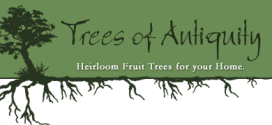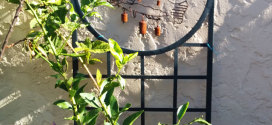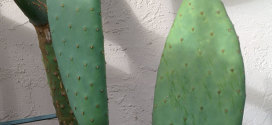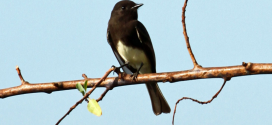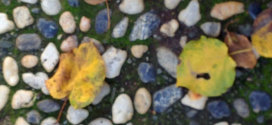tbd
Read More »admin
Trellis – Circular
Circular trellises are a great design element. You can hang decorative elements, especially those that move in the wind. We use ours for anchoring the marionberry canes. The height is 84 inches unplanted (76 when planted).
Read More »Nopal Cactus
Nopal (also known as the Prickly Pear cactus) is hardy, drought-tolerant, and reproduces easily by cuttings. Forty years ago I took a small cactus pad from the home of my wife’s grandmother in Hollister California. Nopal is a species and an ingredient made from the Opuntia cacti, in the subfamily Opuntioideae. They are particularly common in their native Mexico where …
Read More »Black Phoebe
The black phoebe is a common visitor in the Sunnyvale garden. It is mainly insectivorous and waits on a perch before flying out and catching its prey in the air. (Sayornis nigricans) is a passerine bird in the tyrant-flycatcher family. It breeds from southwest Oregon and California south through Central and South America. It occurs year-round throughout most of its …
Read More »Annie’s Annuals
Annie’s Annuals is a great source of live plants that are not carried by the big-box stores. They are the equivalent of an indie-record store (an analogy for those over 40).
Read More »Yamagami Nursery
Yamagami Nursery is my local nursery for live plants in the Sunnyvale/Cupertino area. They also carry a big selection from Annie’s Annuals. Address: 1361 S De Anza Blvd #2, Cupertino, CA 95014 Phone:(408) 252-3347 Hours: Open today · 9:00 am – 6:00 pm
Read More »ChilePlants.com
The Crosswinds Nursery in New Jersey runs the ChilePlants.com website. It is an excellent source of live plants. Order in early April when planting in Sunnyvale California. As of Dec 2014, they offer 500 varieties of chile peppers; 180 varieties of tomatoes; and 65 varieties of Eggplants
Read More »Tomatofest
Gary Ibsen’s tomatofest is our website for Tomato seeds. Every christmas, I get a gift from my wife of 12 types of tomatoes.
Read More »First Line of Defense – Plan Ahead
You should start prevention of garden problems before a single seed is planted. Resist the temptation to just start digging. Instead, observe your garden. What parts receive sun and for how long? Where does water accumulate or drain?
Read More »Second Line of Defense – Prevention Strategies
Most of the defensive actions discussed here are organic remedies for a host of diseases and animal pests. Plant Maintenance Avoid deep planting Water from below Water before noon Don’t work around or touch wet plants Don’t touch healthy plants after working with diseased plants Avoid high-nitrogren fertilizers Feed the soil with compost Mulch in spring and fall Control weeds …
Read More »